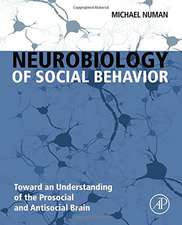New Concepts in Neurotransmitter Regulation: Proceedings of a Symposium on Drug Abuse and Metabolic Regulation of Neurotransmitters held in La Jolla, Californina, in July 1972
Editat de A. Mandellen Limba Engleză Paperback – 8 oct 2011
Preț: 373.33 lei
Preț vechi: 392.97 lei
-5% Nou
Puncte Express: 560
Preț estimativ în valută:
71.45€ • 74.31$ • 58.98£
71.45€ • 74.31$ • 58.98£
Carte tipărită la comandă
Livrare economică 14-28 aprilie
Preluare comenzi: 021 569.72.76
Specificații
ISBN-13: 9781461345763
ISBN-10: 1461345766
Pagini: 332
Ilustrații: XII, 316 p.
Dimensiuni: 170 x 244 x 17 mm
Greutate: 0.53 kg
Ediția:Softcover reprint of the original 1st ed. 1973
Editura: Springer Us
Colecția Springer
Locul publicării:New York, NY, United States
ISBN-10: 1461345766
Pagini: 332
Ilustrații: XII, 316 p.
Dimensiuni: 170 x 244 x 17 mm
Greutate: 0.53 kg
Ediția:Softcover reprint of the original 1st ed. 1973
Editura: Springer Us
Colecția Springer
Locul publicării:New York, NY, United States
Public țintă
ResearchDescriere
Historically, the development of biological science has proceeded from the anatomy to the physiology of particular systems. Knowledge about neurotransmitters in the brain has evolved from the discovery of the compounds per set through the elucidation of their biosynthetic and degradative pathways, and finally to the current focus, the regulation of these processes. Regulation in a biological system implies the capacity to respond to perturbations. The introduction of standard and speci fiable disturbances in a biological system followed by examination of the mechanisms involved in response, i.e. that dampen and/or cancel the induced changes, has proved to be a successful way to elucidate regulatory mechanisms. Psychotropic drugs have been most useful to students of regula tory mechanisms in that calvarial prisoner, the brain, for they allow prospective manipulation of variables like dosage and time. Those of us interested in the biological substrata of behavior are especially excited that disturbance induced by drugs leaves the organism intact and behaving, and we can observe behavioral correlates. The pharmacological strategy is, of course, not unique to brain scientists. The relationship between psychotropic drugs and our emerging knowledge of neurotransmitter regulation is, for example, akin to the development of anticancer agents in company with the uncovering of many mysteries of molecular biology.
Cuprins
Neurotransmitter Regulation and Enzyme Synthesis.- Multiple Measures of Compensatory Adaptation in Catecholamine Biosynthesis.- Control of Synthesis, Transport, and Release of Dopamine-Beta-Hydroxylase and Tyrosine Hydroxylase.- New Enzyme Synthesis as a Long-Term Adaptation to Increased Transmitter Utilization.- Neurotransmitter Regulation and Enzyme Activity.- Some characteristics of Brain Tyrosine Hydroxylase.- Tyrosine Hydroxylases Subcellular Distribution and Molecular and Kinetic Characteristics of the Different Enzyme Forms.- Norepinephrine Biosynthesis in Relation to Neural Activation.- New Approaches to Neurotransmitter Regulation.- Use of Single Unit Recording in Correlating Transmitter Turnover with Impulse Flow in Monoamine Neurons.- The Role of 3’ ,5’-Cyclic Adenosine Monophosphate in the Regulation of Adrenal Medullary Function.- The Use of Autoradiographic Techniques for the Identification and Mapping of Transmitter- Specific Neurones in CNS.- Neuronal Uptake of Neurotransmitters and Their Precursors: Studies with “Transmitter” Amino Acids and Choline.- Multivariate Considerations in Neurotransmitter Regulation.- Central Noradrenergic Receptors: Localization, Function, and Molecular Mechanisms.- Regulation of 5-HT Synthesis in Central Serotonergic Neurons.- Redundant Macromolecular Mechanisms in Central Synaptic Regulation.- Opiate Drug Effects and Neurotransmitter Regulation.- Relation of Brain Serotonin to the Inhibition and Enhancement of Morphine Tolerance and Physical Dependence.- Recent Studies on the Binding of Opiate Narcotics to Possible Receptor Sites.










